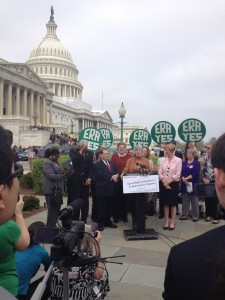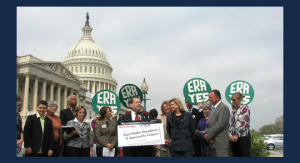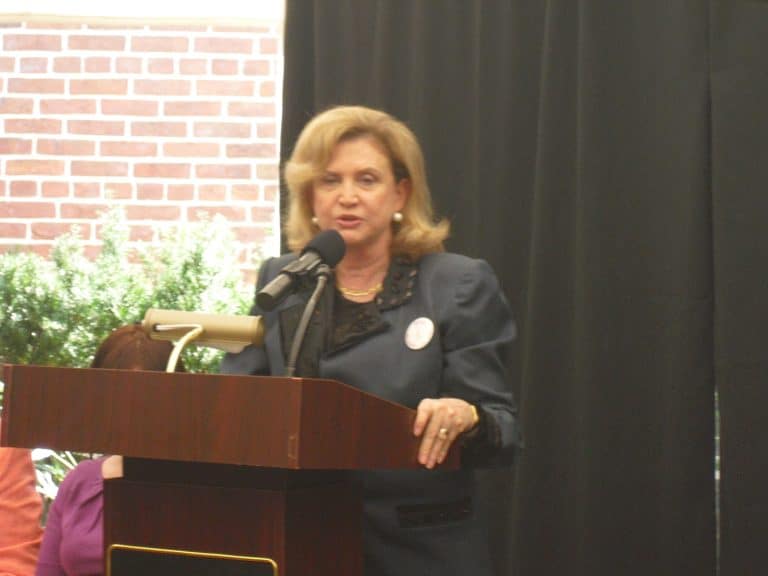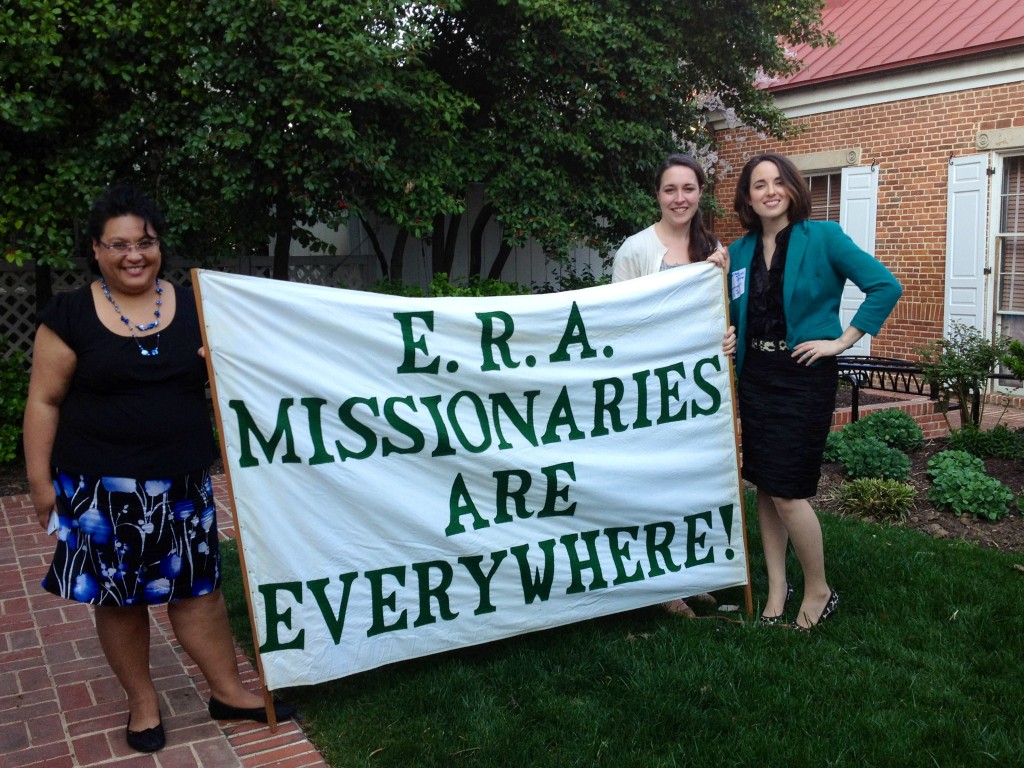 This picture was taken at a press conference for new bills introduced into Congress and Senate for The Equal Rights Amendment (ERA) during the 40th anniversary on March 22, 2012 of the March 22, 1972 passage of the ERA through Congress. I was so inspired by this program that I decided to create a series of posts dedicated to the ERA’s past, present, and future. In the first post I gave some background information on the equal rights amendment, in next post I outlined my personal journey from knowing nothing about the ERA, to reading From Housewife to Heretic, to becoming a National Council for Women’s Organizations Mormons for ERA Activist! This final post will be dedicated to the future of the ERA, why it is so important and what you can do. Check out the official ERA website for more information: www.equalrightsamendment.org *Caveat: All quotes are taken from my rapidly written notes from March 22, 2012 and any mistakes in their translation and reproduction are entirely mine.
This picture was taken at a press conference for new bills introduced into Congress and Senate for The Equal Rights Amendment (ERA) during the 40th anniversary on March 22, 2012 of the March 22, 1972 passage of the ERA through Congress. I was so inspired by this program that I decided to create a series of posts dedicated to the ERA’s past, present, and future. In the first post I gave some background information on the equal rights amendment, in next post I outlined my personal journey from knowing nothing about the ERA, to reading From Housewife to Heretic, to becoming a National Council for Women’s Organizations Mormons for ERA Activist! This final post will be dedicated to the future of the ERA, why it is so important and what you can do. Check out the official ERA website for more information: www.equalrightsamendment.org *Caveat: All quotes are taken from my rapidly written notes from March 22, 2012 and any mistakes in their translation and reproduction are entirely mine.
 Representative Carolyn Maloney (D-NY)
Representative Carolyn Maloney (D-NY)
“Did you know that women die in car accidents 30% more than men? Why? Because safety and seat belt studies are conducted on male bodies.” This is how Congresswoman Carolyn Maloney (D-NY) began her remarks at the “Forty Years of ERA” program last March. I was taking notes and looked up after she began. While my eyes were glued to her magnetic presence in the front of the room that screamed “capable, capable, capable” as if from a glowing neon sign, my thoughts drifted to my own body. About how I purposefully scoot my seat as far forward as it can go so I feel more in control when I drive, about how my seat belt digs into my collar bone and I sneak it underneath my armpit to avoid the discomfort, about how my body did not seem to fit either the seat or the belt when it was large with child. These thoughts made me feel both flummoxed and angry at the same time. As a very safety conscious person I wondered how I did not know this before and whether I have been endangering myself or my daughter every time I drive.
Then Congresswoman Maloney continued, “It is a similar problem that we faced when we discovered that medications were tested on only male rats eve though we know they metabolize differently in females. It took a lot of effort, but we finally fought for gender equality in pharmaceutical research.” I was astounded again. These were not secondary issues these were the difference between life and death for hundreds of thousands of people all due to discrimination (conscious or not) against women in fields as varied as the automobile industry to the drug industry. Think about the new contraceptive debates, the 18 states that have different initiatives trying to roll back women’s health, the fight against the affordable health care act, the ridiculous positions against the Violence Against Women Act, the fight against Medicaid which disproportionately impacts women as they make up 70% of nursing home populations and how social security restrictions discriminate unfairly against women who work in the informal sector of motherhood. All of these issues are connected. They are just a few of the cases where women are not protected against discrimination under the law.
 Eleanor Smeal, ERA Founding Mother
Eleanor Smeal, ERA Founding Mother
The Equal Rights Amendment (ERA) has been arguing for protection against gender discrimination since 1923. If we had the ERA we would not have to individually fight all these little battles. “There are over 800 federal statutes that discriminate against women on the basis of sex, according to the United States Civil Rights Commission. If it takes 8 years to change 14 laws [Reagan brags about having changed 14 laws for women in the state of California during his two terms as governor], according to my arithmetic it would take 457 years to change 800 laws. We may be a patient people, but that is ridiculous” (Eleanor Smeal, National NOW times, Oct/Nov 1980). And that doesn’t even include all of the state discriminatory statutes! Moreover, most ERA proponents are worried that implementing the ERA now in the current political climate is not even moving forward, it is making sure we don’t go backwards!
 Representatives Jerrold Nadler (D-NY) and Carolyn Maloney (D-NY) at the ERA press conference.
Representatives Jerrold Nadler (D-NY) and Carolyn Maloney (D-NY) at the ERA press conference.
Representative Jerrold Nadler (D-NY) continued on this thought during the same program by arguing that “instead of fighting all of these one at a time we need a guarantee; a constitutional guarantee. Discrimination based on gender is NOT protected under the 14th amendment so we need this. Now. It’s our job to make it available to all now so that we can enjoy it and not just our grandkids.” When it comes down to enforcing and enacting the law women are not protected against discrimination regardless of some people’s interpretation of the 14th amendment. As Justice Scalia made clear when he said, “Certainly the Constitution does not require discrimination on the basis of sex. The only issue is whether it prohibits it. It doesn’t. Nobody ever thought that that’s what it meant. Nobody ever voted for that. If the current society wants to outlaw discrimination by sex, hey we have things called legislatures, and they enact things called laws. You don’t need a constitution to keep things up-to-date. All you need is a legislature and a ballot box…Persuade your fellow citizens it’s a good idea and pass a law. That’s what democracy is all about.”
As it stands, ERA ratification bills were introduced in the Senate (S.J. Res. 21) by lead sponsor Senator Robert Menendez (D-NJ) and in the House of Representatives (H. J. Res. 69) by lead sponsor Representative Carolyn Maloney (D-NY) on June 22, 2011. A few months earlier in March 2011 a resolution was introduced which would remove the ERA’s ratification deadline and make it part of the Constitution when three more states ratify (J. J. Res. 47) by Representative Tammy Baldwin (D-WI) and a companion bill (S. J. Res. 39) was introduced in the Senate by Senator Benjamin Cardin (D-MD). Speaking on the progress of these bills Senator Menedez (D- NJ) congratulated Representative Maloney as the best possible person to get the job done and explained that he already had 14 colleagues as co-sponsors and that those numbers were growing and they were speaking to members of the senate to continue this progress.
 Senator Robert Menendez (D-NJ)
Senator Robert Menendez (D-NJ)
For all intents and purposes, Congresswoman Maloney might just be the woman who can get the job done after all of these years and she has stated that within her tenure this will be the battle she charges. But, she argues, she can’t do it alone. It is our own fault if it does not pass. “We are 52% of the population. It is our own fault. If we worked together it would pass” said Maloney. She continued, “We need to write to our Congresspeople to sponsor the bills, we need to educate, promulgate, petition, and join together.” Then Representative Maloney gave a list of specific things we can do to support and strengthen the ratification of the ERA:
1) Set aside 30 minutes a week strategizing to get senators as co-sponsors on the bills.
2) Make a list every week of a new outrage: publicly announcing a representative or senator who won’t sponsor the bill, legislation that goes against it, quotes that are discriminatory, etc. We do this for other things, why not ERA?
3) We need to be more demonstrative. Ask federal automobile safety to explain why there are no safety tests designed for women’s bodies. We need to hold press conferences and raise awareness when we discover cases of gender discrimination.
4) We need to find examples of the latest outrage and get it out there. Everyday there is discrimination against women and American women have a responsibility to make that happen. Other organizations have wielded power by exposing poor voting records or statements of discrimination and have done a lot of good by publicizing bad behavior- no one wants to be scored and it’s our duty to hold people accountable for their actions against women.
5) We should have a score card to rate all of the legislative happenings and score how each congressperson and senator does on their votes against women. Many organizations already do this. Why don’t we? No one wants to put anything to a vote and then be publicly responsible and have to defend to more than 50% of the population of why they voted against their interests. This is our duty to point out, to educate, and publicize.
6) Each of us needs to think about what we can do in our own lives. We know from studies that when women get equality there is better peace and prosperity for all. It’s up to the women. No one will do that for us and if we don’t win it and get equality in a privileged land it’s our own fault. What of those countries where women are worse off?
7) We need to bond with every group, add new sponsors, and ask America to go ask their congress people to pass this. It’s up to you!
8) Each one, reach one. Each group and each individual need to contact a congress person and senator. Divide them up and become responsible for the ones in your state. Then hound them. Letters, emails, and phone calls. Don’t make it easy for them to ignore such a huge issue. We need to get the vote onto the floor and show how different people vote so we know who to push further.
9) Ultimately we need more equal representation in decision making bodies, from government to education to business to religions. Women hold only 16.8%, of the 535 seats in the 112th US Congress, 17.0%, of the 100 seats in the Senate, 3/9 Supreme Court Judges and have never been in executive office in this country. Compared to the rest of the world, the United States rates 90th in the number of women in national legislature. Combine these statistics with disproportionate ratios in representation and decision making power in religions, media, business, health care and academia and it is no wonder that women’s interests are not being addressed.
Hearing all of these legislative leaders passionately discuss the ERA inspired me. It gave me hope and a determination to do whatever in my power to join the cause. I was there as a representative of Mormons for ERA, which right now is just a loosely organized group of like-minded Mormon feminists, but in that moment I was transformed into something more—a representative for the cause of women across the globe. The ERA, to me, means that women enjoy all of the same rights, privileges, liberties, freedoms and protections as men, not just in thought or word, but also under the penalty of law. It means that women are protected by something larger that civility, chivalry or honor, values which have failed women greatly throughout history. It means that women can rightfully expect to be treated fairly and when they are not they can pursue legal action with a chance or hope of winning. The ERA, to me, means not just the end of a long and tortuous battle against gender discrimination but the beginning of a world in which increased women’s representation changes global rates of war, scarcity, inequality and suffering.
The ERA ratification might happen in as few as two years. It might take another 23. But I am certain that within our lifetime this is an issue we will face which will radically change history. But it won’t be easy and if the history of the ERA has taught us anything, it won’t be fast. What will we do as women and, more importantly, what will we do as Mormons when that day comes? That is the point of this post. I want all of us to think and discuss: What will we do when the time comes? What is the best route to successful ratification? How can we be the most effective? How can we change erroneous opinions? How can we balance obedience to leaders with the obvious morality of legal protection against discrimination?
Representation Maloney urged us to think beyond religious binaries, “For too long women’s issues have been masked under the guise of religion. I’m religious and this is a very religious country. These issues are NOT religious. President Obama has made it clear that churches can have their own rules, but when they serve the public using federal money they need to follow federal rules. It is about money and yet these arguments invariably go after women’s rights. If we had the ERA many of these things couldn’t happened.”
Viewing the ERA outside of a religious lens and focusing on the humanistic and social justice realities of the resolutions, how can we understand what action to take in the future with the ERA as Mormons and what can we learn from the precedents established in the past? Fortuitously, this week the Church of Jesus Christ of Latter-Day Saints’ Newsroom, the official resource for new media, opinion leaders and the public came out with a statement under the title “Getting It Wrong” where they claimed “Neil J. Young, a Princeton professor, says the Church’s weighing in on the Equal Rights Amendment in the 1980s was ‘based on a revelation.’ This is incorrect. However, the Church reserves the right as an institution to address, in a nonpartisan way and in accordance with its doctrine, issues that it believes have significant community or moral consequences or that directly affect the interests of the Church.”
This statement, the past ERA battle and the more recent controversy of Proposition 8 in California have taught us many things about church political action and member response. First, that the church’s political stances are not commandments or revelations, that we are officially allowed to have different opinions, and that we have been publicly encouraged to make sure these differences are expressed with civility and mutual respect. Second, that regardless of public official statements members will often engage in unofficial pressure tactics to encourage compliance with church opinions that range from judging one another’s worthiness to taking temple recommends and facing church disciplinary councils. We also know that some members take these matters to the extreme by discussing political issues in church meetings, using words bordering on hate speech and refusing to allow the space for variable opinions within a congregation. Third, we have found with the increasing public support of gay marriage by members that internal opposition to the church’s stance may appear years after the official church statement, long after most of the damage has been done. Fourth, we know that many church buildings, resources, time and money is devoted to the causes supported by the church and against any opposition. If the last ERA battle or Prop 8 has taught us anything it is that our leadership is not immune to the vagaries of politics. Finally, we also know that many members will equate the church’s stance with a moral issue of obedience to the brethren rather than the specifics of the legislation, so that it is near impossible to discuss the details of the ERA if people’s decision are based on the general value of loyalty over knowledge. In fact, many know very little beside the church’s position. Knowing these factors, what can we do as Mormons to prepare for the ratification of the ERA with the assumption that the church will maintain their original stance of opposition to it? What worked last time? How can we do things differently this time?
At the end of the “Forty Years of ERA” program I was motioned from the room by the chair of the ERA task force for the National Council of Women’s Organizations (NCWO). She brought me into a small room and told me that she had a present for me. I was completely surprised by her attention and generosity and waited with baited breath as she pulled out a large cloth banner from the ERA protests during the 1980’s. As she began to unroll the banenr my breath caught and I got teary eyed. It was a cream canvas with hand sewn forest green fabric letters which said, “E. R. A. Missionaries Are Everywhere.” I didn’t know quite what to say other than to close my hanging jaw and whisper, “Wow. Thank you.” Then she explained that this banner had been sitting in a NCWO headquarters and they didn’t know what to do with it. It was from a time when Sonia Johnson and the Mormons for ERA were major strategists and participants in the movement for ERA ratification and they sent women out two-by-two to go knock door-to-door and proselyte the cause of the ERA in unratified states using the Mormon missionary program as an example! Seeing and touching this sign was one of the most surreal moments of my life and it connected me to a line of sisters that extended back through the generations of Mormon Women past, present and future who worked for the rights and protection of women against discrimination, from our early suffragette sisters in Utah who fought for the right to vote to our battle-scarred sisters in the 70’s and 80’s who suffered through the last ERA battle to current and future Mormon feminists who are ready to take up the cause. This isn’t a quaint issue that our mother’s faced or even a controversial bipartisan argument. This is OUR civil rights movement; one that will not just be handed to us, one we have yet to demand, one that we have to fight. Let’s get started!







17 Responses
Might be a reaction because of where I work, but my first thought on reading about that banner was, “That -so- needs to be the centerpiece of an exhibit in the Church History Museum!”
On the other hand, which would be more powerful, to see it being used again or viewed as a relic?
There is no way that the ERA will pass if you have only Democrats supporting it. Almost all of the “no” states are predominantly Republican now. Also, do not bring the very current and unpopular Obamacare into this discussion to help push the ERA. Most people object on gender neutral rationale. Of course, with the Roberts SC decision, the gender neutral parts are getting heavy emphasis.
Some of the gender biased results are very good to bring up. The 30% auto fatality imbalance is big. This is about the difference in body weight between the average man and woman, but I doubt that is the sole reason for the discrepancy.
Forty years ago Mormon women were instrumental in rolling back the passage of the ERA.
It would be fitting if now Mormon women looked at it again with clear eyes and helped to secure it for our daughters and grand daughters.
Amen!
The anecdotal evidence of discrimination you shared here (the seatbelt example, the drug testing, etc.) was startling and compelling. I’m not willing to let equality take more than 800 years to be accomplished.
Until very recently (and I’m not sure to what extent the situation has actually been corrected) all of the medical research on heart attacks and heart attack prevention has been based on male anatomy. Meanwhile, the symptoms of heart attack in women are very different.
My own m-i-l went from doctor to doctor describing the troubling and debilitating symptoms she was experiencing for an entire month. She went home with antibiotics, anti-depressants, advice to take it easy and advice to stop fixating on it and carry on. Eventually the situation “resolved” when she had a massive coronary and was dead before the ambulance reached the Emergency Room.
All of this was preventable.
It happened almost 40 years ago and I’m not entirely over it yet. And I don’t entirely know that it couldn’t happen again to some other woman.
I’m so sorry to hear that your MIL passed away because no one would listen to her. When I teach first aid and CPR classes, or get a chance to talk about health wellness to any person or group I always make sure to tell them the signs/symptoms of heart attack in women and how they are different than men. I also talk about the men, but when I do health education I tend to focus on women because there is so much out there already that focuses on the men.
Twenty years ago I took a general-education science course taught by (of all things) a linguistics professor. We spent the whole semester analyzing the language of science in contrast with the languages of religion, politics, and gender. I think it was the most valuable class I’ve ever taken.
The language we use in science and research defines the male body as “normal” and the female body in terms of how it differs from the male. People are inclined to see a group as predominantly female even if it’s two-thirds male. Socially, we habitually put men’s names first and women’s names second, take our husbands’ last names without thinking twice (guilty), and generally assume that a couple that’s new to the ward must be there for the husband to pursue an education or career (guilty, guilty, guilty).
The language I hear from the political right these days is the language of patriarchal religion, categorizing women as either madonnas who need male protection or whores who are undeserving of human rights. It’s very different from what I hear in the scriptures, where “all are alike unto God.” Here’s hoping that someday soon we will all be alike in our importance to auto manufacturers, to pharmaceutical companies, to the Social Security system, and to voters.
(And the ERA missionaries banner is awesome!)
I think the reality that we continue to think of male as “normal” and female as a departure from “normal” is such an important, but unfortunately invisible, contributing factor to ongoing sexism in our society. The examples given of crash testing, medical/pharmaceutical research, etc., are just evidence of how much that mentality pervades our society in spite of decades of progress towards gender equity. One thing the ERA could help do is overtly combat such implicit prejudice and harm.
I agree that this is a problem, and in doing technical editing for NIH-funded projects, I have caught this kind of male-normative thing.
However, I don’t see the ERA contributing to any improvement. In my experience, the people doing this kind of research consider themselves feminists. But they consider “discrimination” a negative word, and think that you achieve equality by treating everyone the same. So that mindset is exactly what has caused them NOT to treat women differently, appropriate to their biology.
Something that I waited for followup when it was first said and I’m still waiting, came from Elder Packer at the time the Church entered the fray against the ERA. As I remember it, he said, “There are many things that need changing for women, some of them desperately need changing, but the ERA is not the way to do it.” OK, I thought, I wondered what we would lead out in, if not the ERA. The silence has been deafening. The Church would have a lot more credibility if, even though they opposed the ERA, they had led out in some of the issues that even, at least some of, the leadership claimed needed changing–desperately.
I completely agree! I have often had the exact same thought. There was a lot of rhetoric at the time agreeing that women’s rights were not where they needed to be and that not only did we need individual laws and protections changed, but we even needed a large sociocultural statement that stirred the country in the right direction regarding women and mother’s rights….but not via ERA. Guess what? All this time. All our waiting. All the rhetoric of how much the church loves and supports women and mothers and not once have they stood for an initiative let alone a bill or amendment or a movement to help women in any way! They profess with their lips, but their hearts are far. I guess I just wish we put our money where our mouths were. If we care so much about families, let’s do the main things that studies have shown support families: increased women’s education, equal pay, flexible work schedules, paid maternal/paternal leave, small loans to women, affordable quality child care, affordable health care, etc. etc. etc.
Having read THE FEMININE MYSTIQUE before coming to BYU in 1977, it was neat to see so many of the principles espoused in the book put into action. At the time, BYU offered part-time scholarships for moms, whereas at the equal-opportunity university I am affiliated with now, moms can’t even go to school part-time at their own expense (has to be full-time or nothing). Consistent with what was described in TFM. there was a summer program at Helaman Halls that allowed moms to bring their kids and come back to finish a degree or recertify; that’s how June Oaks finished her degree. And it was fun having those women in classes and getting to know them. I also had several distance-learning scholarships (courses I did at the playground) without which I couldn’t have gotten into grad school. There was a married couple of professors at the law school who had a room with a playpen and child equipment in between their offices, and staggered their class schedules to they could take turns caring for their baby. When I was pregnant and sick and couldn’t do my best in class, professors were great about letting me turn in term papers later; in contrast, I watched a classmate at a state university be flushed out of the program because she couldn’t keep up with the work.
And Risa over at fMH talked about how she works for the church, and she has a part-time professional position with supportive supervisors.
My girls have all gotten great encouragement to seek higher education, both over the pulpit in conference and the young women leaders were wonderful at ensuring there were enough service opportunities for the young women to qualify for a scholarship that requires a certain number of service hours.
So I have found the church to be pretty supportive of many things that help women.
Thank you for this series of posts on the ERA. I think it was the ERA fight in the 80s that was the embryo of my feminist awakening. I supported the LDS Church position, because that is what I was told to do, but it thoroughly confused me. It made no sense to me that a Church which preached the holiness of women would not support them in a fight for equal rights.
“….how social security restrictions discriminate unfairly against women who work in the informal sector of motherhood.”
Since social security is currently gender-neutral, it is hard for me to see how the ERA would change anything about social security. This seems a straw woman argument in favor of ERA.
Currently there is a spousal benefit for social security recipients. If a couple stays together through retirement, this works very well. The downside is that if a couple divorces in less than 10 years, a partner who is a fulltime parent has nothing to show for those years. I support giving credits to fulltime parents for their years of service at home, I just don’t support (1) doing away with the spousal benefit and (2) the limitations found in current iterations of such proposals.
To review a bit of history from the era of the last round of ERA ratification, during the early Reagan years a commission on social security was convened. One of the members was Rita Ricardo-Campbell, a senior fellow at the Hoover Institution in Palo Alto, Calif., and a feminist who supported ERA. She proposed to a congressional subcommittee that the dependent spouses’ benefits be phased out over 30 years, and also phasing out over 50 years the full retirement benefits that a surviving dependent spouse automatically gets upon the death of their retired husband or wife.
She said, “My plan … recognizes the major socioeconomic changes of the last 30 years: the revolutionary increase in the number of women in the paid labor force, the decline in the marriage rate and the increase in the divorce rate.”
This is from an Associated Press article that ran March 6, 1981 entitled, “Phyllis Schlafly Assails Proposals to Change Social Security,” which ran in many newspapers.
Schlafly countered: “The fact that millions of wives have entered the labor force is no argument at all for taking away benefits from those who remain in the home.”
Those who stay at home, she argued, “are the greatest financial asset the Social Security system has. By bearing and nurturing six children, who have grown into educated and well-adjusted citizens who will pay decades upon decades of taxes into the Social Security system, I have done vastly more financially for the Social Security system than any worker who pays taxes into the system all his or her life.”
Under the plan proposed in 1981, a woman would be given two or three years of earnings credit toward Social Security benefits for her first two children only. The proposals I have seen more recently say a total of five years. And that is for BOTH childcare AND elderly care.
If we really trust women to make their own reproductive choices, and if we truly value caregiving, then why these limits? As Mormon women entitled to personal revelation about issues such as the number of spirits who need to come to their own family, can we support public policy that is coercive in limiting family size and discourages homecare of elders?
I just don’t think these issues are as simple as some would make out. ERA is not a magic wand.
I’m so glad to discover this blogsite and specifically, a post about the ERA. I’m an older feminist woman (65) who was shocked when the ERA didn’t pass in the 1970s. I also helped to host Sonia Johnson as she lectured here in the late 1970s. Sonia was a Mormon woman who was excommunicated because she supported the ERA. So seeing Mormon women pushing for the ERA is a welcome experience. Yay!
[…] When polygamy disappeared from the horizon, women’s rights became much less important. (See Whoa-man’s brilliant series on the ERA). […]